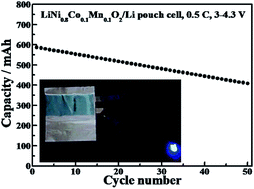Nonflammable quasi-solid-state electrolyte for stable lithium-metal batteries†
Abstract
Rechargeable lithium batteries with high-voltage/capacity cathodes are regarded as promising high-energy-density energy-storage systems. Nevertheless, these systems are restricted by some critical challenges, such as flammable electrolyte, lithium dendrite formation and rapid capacity fade at high voltage and elevated temperature. In this work, we report a quasi-solid-state composite electrolyte (QCE) prepared by in situ polymerization reactions. The electrolyte consists of polymer matrix, inorganic filler, nonflammable plasticizers and Li salt, and shows a good thermal stability, a moderate ionic conductivity of 2.8 × 10−4 S cm−1 at 25 °C, and a wide electrochemical window up to 6.7 V. The batteries with the QCE show good electrochemical performance when coupled with lithium metal anode and LiCoO2 or LiNi0.8Mn0.1Co0.1O2 cathodes. Pouch-type batteries with the QCE also exhibit stable cycling, and can tolerate abuse testes such as folding, cutting and nail penetration. The in situ formed fluorides and phosphides from the plasticizers stabilize the interfaces between the QCE and electrodes, which enables stable cycling of Li metal batteries.



 Please wait while we load your content...
Please wait while we load your content...